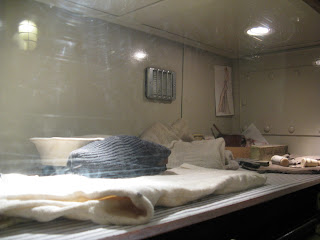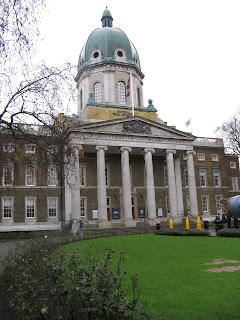We had the choice of two stations to get to our destination today, on the map both seemed within equal walking distance to the Imperial War Museum. Now given that we could choose between Lambeth North and the next stop and end of the line, Elephant and Castle, there really was no choice, Elephant and Castle won hands down! Just the name was a draw-card. We had read it on the destination maps on the train almost every trip we’d made and were eager to find out what was there. Could it be an elephant and/or a castle? Well no, neither actually but there was a pub not far from the station by the same name.
The War Museum was about 250 metres from the station and easy to find as it is well sign posted. The building it is housed in has a high domed roof and columned entry portico and sits in neat gardens with two large 15 inch naval guns at its entrance. The building the Museum occupies was once the central portion of The Bethlem Royal Hospital, also known as ‘Bedlam’ parts of the building were demolished in the 1930’s to make way for the gardens. The hospital has a long and intriguing history of its own dating back to 1247. However, the hospital was only housed in this building between 1815 and 1930 and the War Museum opened here in1936. Stepping inside there is the usual bag search, something I have become used to. You have to open your bag for inspection before you can take it into the Museum, we first encountered this security measure in France and it is now just second nature to present your handbag when entering a Museum or Gallery.
 The gun on the left (from the firing end not the shooting end!) was mounted on HMS Ramillies in 1916 and saw action in 1920 in the Greco-Turkish war and again against the Italians in 1940. The gun on the right, was mounted on HMS Resolution between 1915 and 1938 and also saw acrion in the Greco-Turkish war. It was re-mounted on HMS Roberts and took part in the invasion of Normandy in 1944
The gun on the left (from the firing end not the shooting end!) was mounted on HMS Ramillies in 1916 and saw action in 1920 in the Greco-Turkish war and again against the Italians in 1940. The gun on the right, was mounted on HMS Resolution between 1915 and 1938 and also saw acrion in the Greco-Turkish war. It was re-mounted on HMS Roberts and took part in the invasion of Normandy in 1944The first view you have on entering is a big high open hall with tanks, mini subs military vehicles and shells of all descriptions, there is even a very intriguing Dr Who looking contraption that turns out to be a portable air raid shelter. Suspended from the roof at different levels are several aeroplanes from different eras, they are able to be viewed from all four levels of the gallery.
 M3A3 Grant tank used by Lt. General ( later Field Marshal Lord) Bernard L. Montgomery during the battle of El Alamein in October 1942
M3A3 Grant tank used by Lt. General ( later Field Marshal Lord) Bernard L. Montgomery during the battle of El Alamein in October 1942 British B-type motor bus B3 'Ole Bill' used on the Western Front in WW1. Due to a shortage of military vehicles the government purchased a number of London buses, this was one of them.
British B-type motor bus B3 'Ole Bill' used on the Western Front in WW1. Due to a shortage of military vehicles the government purchased a number of London buses, this was one of them. There are superb educational facilities with lots of interactive displays, patronised by school groups of all ages you sometimes have to shove the kids aside to get a go at things like the submarine talking tubes or the headphones that reproduce the sonar sounds of different craft and other things that one might encounter underwater, like a whale. You could also look through a periscope where you were challenged to count the number of ships passing above water! It seems to be true of all the Museums and galleries we have visited especially in UK, they are geared to encouraging young people through their doors and making sure there is plenty for them to interact with.
 the cramped sleeping quarters in a submarine, the small space alotted to one man was narrow and not long enough for a grown man to stretch out unless he was under about 5 feet 6 inches!!
the cramped sleeping quarters in a submarine, the small space alotted to one man was narrow and not long enough for a grown man to stretch out unless he was under about 5 feet 6 inches!!We went up stairs to the Holocaust Exhibition, an extensive harrowing exhibition. There are displays of Nazi uniforms that evoke a feeling of being watched, of superiority. Survivors talk on video of their experiences and memories. There is an area that deals with transportation and the death camps, the entry to this area is through a darkened mock-up of a freight truck, of the type that people were crushed into for transportation to the camps. It is an uncomfortable feeling to walk through this passage, beyond which lies the story of the horrific places and fate that awaited the passengers of the freight trucks. This is a part of the Museum where children under 10 are not encouraged to enter and children of any age are only permitted under the care of an adult.
The area in the huge basement is dedicated to WWI and WWII, with a part that also looks at conflicts and peace keeping history since WWII, there is a display here on the Falklands War with an accompanying video. In the WWI display there is a Trench experience where you can wander through a ‘trench’ with accompanying sound and light.
 The WW1 Trench Experience, I swear there was a very slight sulpher smell as we walked through this darkened grim display, lit up only by my camera flash and the light flashes of 'explosions' and 'gun fire'
The WW1 Trench Experience, I swear there was a very slight sulpher smell as we walked through this darkened grim display, lit up only by my camera flash and the light flashes of 'explosions' and 'gun fire'In the WWII area you can experience what it was like during the Blitz, which we did not get to see, I believe it is set up like a bombed out street scene.
 "Make do and mend" was the message to women during the second world war, They were expert re-cyclers
"Make do and mend" was the message to women during the second world war, They were expert re-cyclers In one of the upper galleries there is a display called Heroes where stories of the George Cross and the Victoria Cross are told alongside of the medals they had been awarded, again there is a lot of interactive activities for children and adults alike. A visit to the Museum shop saw us add to our luggage weight! We left the Museum and walked in the opposite direction to Elephant and Castle underground that had brought us here. We headed instead to the Lambeth North station that was more or less an equal distance from the Museum, with views in the distance of both the London Wheel and thee Houses of Parliament between the houses and buildings we were passing.
 The Houses of Parliament are visible at the end of the street in the centre of this photo as we walked to the station
The Houses of Parliament are visible at the end of the street in the centre of this photo as we walked to the station We stopped on the way home for a feed of bangers and mash, at one of the local pubs as it was nearly 5 o’clock and we were hungry and tired and not relishing the thought of heading out again once we were indoors.



























No comments:
Post a Comment